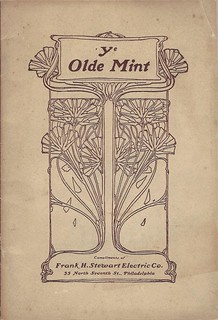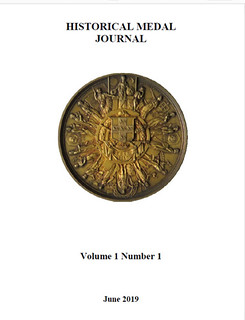
PREV ARTICLE
NEXT ARTICLE
FULL ISSUE
PREV FULL ISSUE
WAYNE'S NUMISMATIC DIARY: FEBRUARY 23, 2020Tuesday, February 18, 2020 was the meeting night of my northern Virginia numismatic social group, Nummis Nova. Our host was Steve Bishop, and he'd chosen Delia's Mediterranean Grill & Brick Over Pizza in Alexandria. I was one of the last to arrive and slid onto a bench next to Julian Leidman and across from Tom Kays and Robert Hoppensteadt. Others already at the table included Jon Radel, Eric Schena, Dave Schenkman, and Mike Packard. Aaron Packard (no relation) arrived a little later and filled in the seat next to me. We'd been there before. It's a small place, but I can't remember ever having a bad meal there. I ordered a glass of wine and shared some of the appetizers ordered by others, including pizza knots and hummus with pita bread. I ordered a roasted walnut salad and the chicken souvlaki. Some numismatic goodies were already being passed around the table, and I added my contribution to the mix. Mints and Minting
First up is the classic Frank Stewart publication Ye Olde Mint. Stewart owned two old Philadelphia Mint buildings and documented their history before replacing them with a new structure for his Frank H. Stewart Electric Company. He authored the 1924 book The History of the First United States Mint. For more information see the Asylum article by Joel Orosz and Len Augsburger, "Frank H. Stewart's Small Beginnings: Ye Olde Mint and Our New Home and Old Times." To read the complete article on the Newman Portal, see:
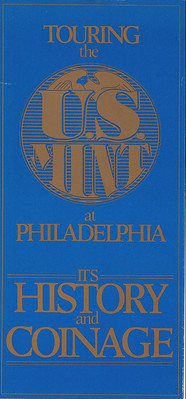 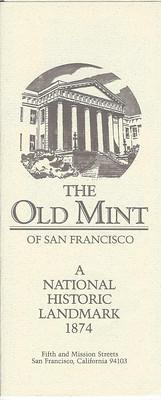 Here are two mint visitor pamphlets. On the left is "Touring the U.S. Mint at Philadelphia". It is undated but pictures 1964 coinage and is apparently from the late 1960s or early 1970s. On the right is "The Old Mint of San Francisco". It is also undated and appears to be from the 1980s. 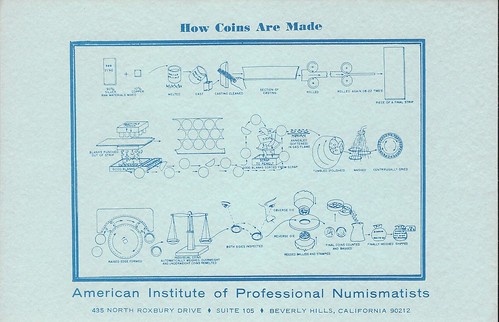 Here's a single sheet illustrating "How Coins Are Made" published by the American Institute of Professional Numismatists. The group also published a rare booklet by Walter Breen called The Minting Process, which I also have a copy of. The Beverly Hills address prompted Julian Liedman to ask if Abner Kreisberg was involved. Can anyone tell us more? Ads in Coin World in 1969 promoted a correspondence course in numismatics: "Now YOU can have the rare opportunity to become a Professional Numismatist with a degree in Numismatics now exclusively available through the recently formed American Institute of Professional Numismatists. Here is your chance to become one of the true Professional Numismatists in this important hobby. No matter what your Numismatic interests or objectives are or how advanced you are a special TAILOR MADE educational course has been designed for you in mind. The course comes in 23 complete separate lessons and is in book length form complete with a final written examination at the end..." The booklet is basically the entire course. My copy has a publication date of 1970 and lists Ronald J. Gillio as the publisher. Bishop's Beauties
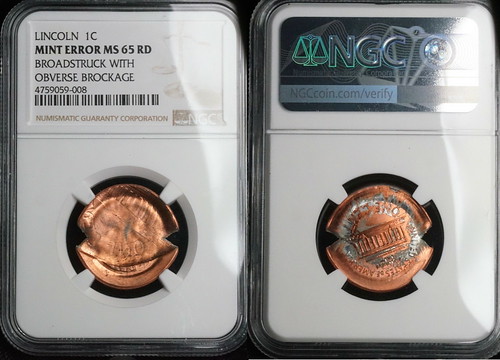 Along with several nice uncirculated Morgan dollars, Steve had these two overstruck Russian coppers. 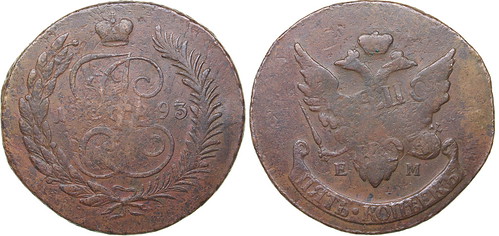
1793 EM 5 Kopecks Overstruck 15 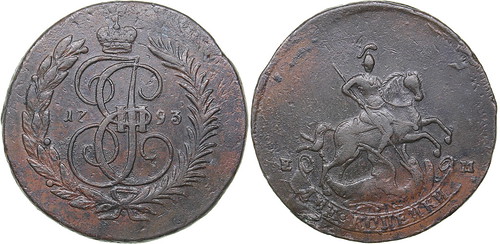
1793 EM 2 Kopecks Overstruck 3 Ivan Varbanov Fantasy Roman Provincial Coins 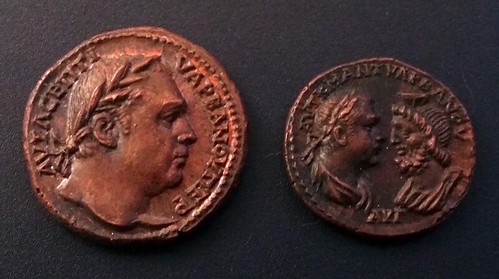 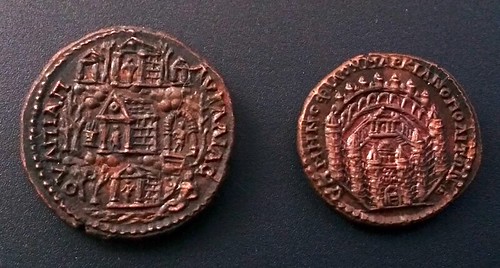 Robert Hoppensteadt brought along these two interesting fantasy Roman Provincial coins. He writes: "I brought two small medallions that were engraved for Ivan Varbanov that copied a couple of famous Roman Provincial coins, only swapping out the emperor with his own likeness. He used to include them for friends who purchased his books. His latest book is THE COINAGE OF PHILIPPOPOLIS. The book is in two volumes of 202 and 420 pages, a full-color, hardcover edition. The data of 8500 coins was used to create the project. These "coins" have become collectible in their own right and even have listings in the Wildwinds database. "Coin on right - Ivan Varbanov, AE27 (copper), based on an issue of Markianopolis, Moesia. AVT K M ANT VAΡBANOV AVΓ, laureate, draped bust of Ivan Varbanov right, facing draped bust of Serapis left, polos on head. / VΠ MHNOΦIΛOY MAΡKIANOΠOΛITΩN, legend ending in a small kantharos-like monogram, city view of Markianopolis, surrounded by wall with thirteen towers, temple and altar within the courtyard. Based on Moushmov 805; Varbanov 1972 of Gordian III. "Coin on left - Ivan Varbanov, AE29 (copper), based on an issue of Pautalia, Thrace. AVT Λ CEΠTI VAΡBANOV ΠEΡ, laureate head of Ivan Varbanov right. / OYΛΠIAC ΠAYTAΛIAC (first AC ligate), View of the Pautalian mountain-temple complex, from top to bottom: central temple with deity standing left within and a tree and small shrine to left and right, another temple with deity standing within and an altar and tree to left and a cave entrance with a figure within and trees to right, another temple with a deity standing within and trees to left. River-god reclining left at the base of the mountain, holding cornucopiae. Based on Varbanov 4833 of Septimius Severus." Robert added that Varbanov had to stop shipping his "coins" with the books after customs officials mistook them for real ancient coins. Marine and River Phosphate Company Ad Note
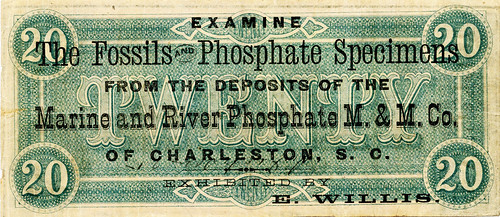 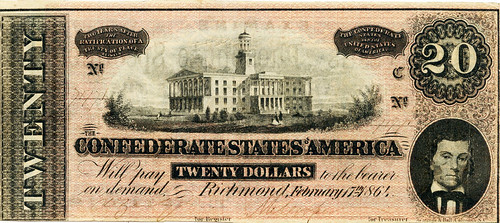 Dave Schenkman always has some interesting new exonumia rarities to share. Here's an advertising piece made by overprinting a $20 Confederate note. He writes: "The Marine and River Phosphate Mining and Manufacturing Company operated from 1870 to about 1883." Manufacturers Coal and Coke Company Cardboard Token
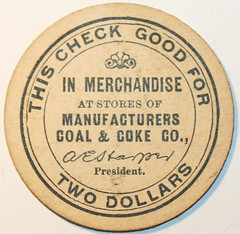 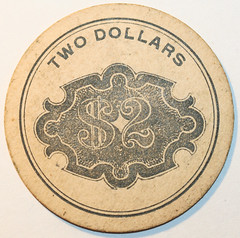 Dave next passed around this rare cardboard token. He writes: "The Manufacturers Coal and Coke Company operated from about 1901 (or possibly a little earlier) to 1913, with mines in Iowa and Missouri, along the Iowa and St. Louis Railroad line. The company's office was in Connellsville, Missouri, a town the company established in 1902." Tennessee Centennial Exposition
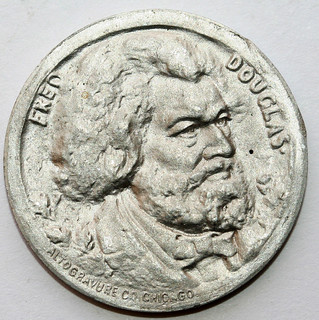 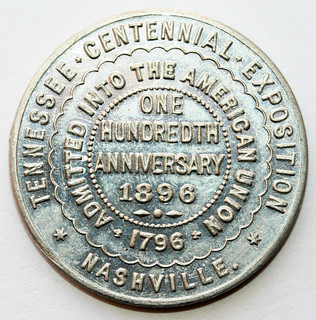 Dave also shared this 1896 medalet of the Tennessee Centennial Exposition featuring "Fred Douglas" made by the Autogravure Company of Chicago. I'd never heard of that manufacturer and a search of the web and the Newman Numismatic Portal came up empty. Can anyone tell us more? South West Africa Chits
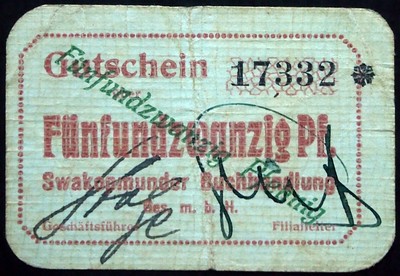 "I brought a pair of what I think are interesting related items from South West Africa (present-day Namibia). In 1915, German South West Africa was occupied by military forces under the Union of South Africa, who would continue to administer the country until 1991 (even though South Africa was supposed to relinquish control in 1922). Coinage was at a shortage before South African coins could be brought into South West Africa, so as a stopgap measure, a bookshop and printer located in the coastal city of Swakopmund was authorized to issue small chits ("gutschein" or voucher) in 1916 that were permitted to circulate throughout the country - the one I brought is good for 25 pfennig. The small chits of Swakopmunder Buchhandlung ("Swakopmund Bookshop") continued to be used until 1918 when they were withdrawn. The shop is still in business in its original location to this day in Namibia." 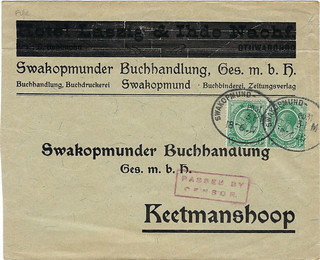 "I also brought a stamped advertising cover for Swakopmunder Buchhandlung dated June 18, 1917 (from the time frame the bookshop's chits were in use) mailed from Swakopmund to a satellite office in Keetmanshoop as an interesting "go-with" that gives a little bit of additional interest." Some British Tokens
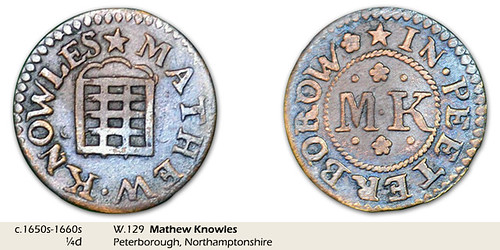 The first specimen is W.129 (W=Williamson) and is from Peterborough, Northamptonshire. It is a farthing, or ¼ a penny, or ¼d. 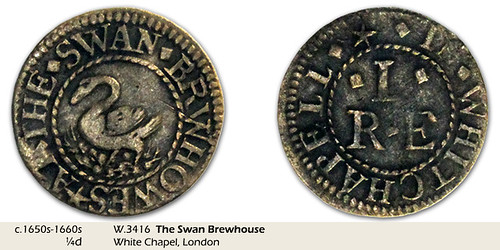 The second specimen is W.3416 and is from Whitechapel, London. It is also a farthing, or ¼ a penny, or ¼d. The primary reason for this series of tokens was due to the chronic shortage of official coins small enough to fulfill the needs of everyday transactions. (Note that this was also recurring phenomenon in the U.S.) They appeared as early as 1648 with several spurts of farthing and halfpence emissions occurring as late as 1666-1667, and then use of them dwindled thereafter. By 1674 only a few places like Chester and Norwich had traders still commonly using them in commerce. To date, there are about 14,000 varieties of this series of emissions cataloged. 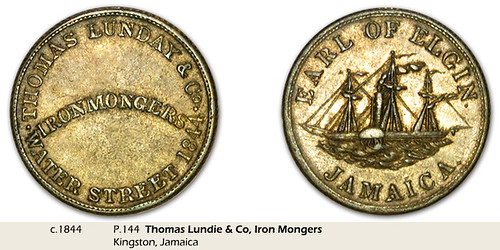 The third specimen is an advertising or fare card from Kingston Jamaica from the 19th century. It was issued by Thomas Lundie & Co. (Note the misspelling.) It measures 23mm in diameter with a diagonal milled edge. It is cataloged as P.144 or Pridmore No 144. The reverse features the paddle steamer ‘Earl of Elgin.' Lundie had brought the ship to the island for use in interisland and coastal trading. However, that venture did not ultimately work out, and by 1847 Lundie had sold it to the government of Haiti. Tom's French Provincial Belle Epoche Medals
All Nummis Nova diners bring "show and share" items to see what gets a rise out of our fellow diners. I could have simply sent Wayne pictures of what I brought, without telling anything about them, but now I have time to tell the story to you, and to those who were seated far down the table from me who are probably still wondering what they saw. After many years of sharing, themes for exhibits have become somewhat eclectic. I brought a small collection of French provincial belle-epoche medals in a small mahogany display case, normally used for archeological artifacts, featuring unlikely but fascinating chapeaux. Digging into possible meanings behind the women's crazy hats I wonder if some French medalists intended to show perspective, while others are firmly planting strange items on the heads of their models. You decide which is which. 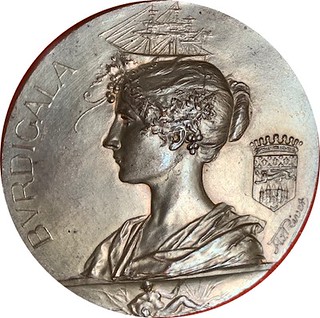 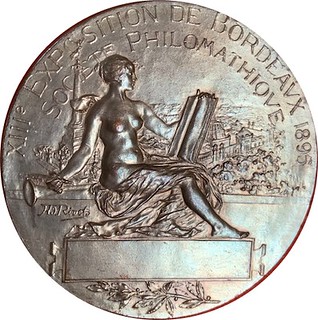 Bronze, Award Medal from the 13th Philomatic Society of Bordeaux Exposition of 1895 by Adolphe Rivet – (62 mm) – Obverse: Wreathed female bust with sailing ship above and Coat of Arms of Bordeaux, "BVRDIGALA" = Bordeaux in Latin. Reverse: Personification of Fame holding stylus and open notebook before a landscape of the exposition grounds in Bordeaux, and olive spray. "XIIIe EXPOSITION DE BORDEAVX 1895" / SOCIETE PHILOMATIQVE. The Philomatic Society of Bordeaux was founded in 1808 and is an association of persons who love the sciences and industry. Of great interest at this expo was an exhibit of wine. From Engineering, Volume 60, The Bordeaux Exposition, of October 4, 1895 we find a complete visitors' description of the expo that ran from May to November. Here is an excerpt: It is satisfactory to find many evidences that viticulture science is rapidly learning to set the efforts of the phylloxers (types of plant louse that ruin vines) at defiance, Besides the collections of French wines, are those of many other countries, of Spain and Portugal, the Rhine, Chili, Italy, California, and Russia (the Czar himself exhibiting wines made on his estates in the Caucasus). Displays of alcohols come from Belgium, Greece, Holland, the Argentina, and Japan." Elsewhere were illustrations as far as possible of the varied applications of electricity, and a very large number of instruments. The Public Works Department of France makes a good display…of lighthouses, buoys, and other signals; there is also a very large model of the somewhat visionary scheme known as the "Canal des Deux Mars" a proposed navigable waterway between the Mediterranean and the Bay of Biscay…Collections of industrial arts such as bronzes, enamels, and jewelry, chemical, and pharmaceutical products, clothing, agricultural machinery, gas and domestic electricity used for lighting, heating, cooking, and transmission of signals, and heavy applications of elevators, motors, and sanitary railway carriages were spread out within the chambers, pavilions, halls, promenades, and among the monuments on the exhibition grounds. Another example. 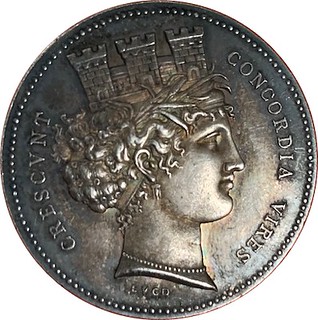 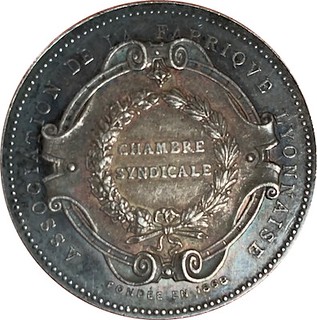 Silver, Award Medal of the Manufacturers Association of Lyon, France by Bonnet – (37 mm) - Obverse: Wreathed Head of Tyche (personification of the City of Lyon) wearing a turreted crown, pearl earrings and necklace, with legend "Crescvnt Concordia Vires," and mint mark "LVGD" for Lugdunum = Lyon in Latin, with "Bonnet" at neck. Reverse: "Chambre Syndicale," Association De La Fabriquve Lyonnaise," and "Fondee en 1868." Marked "Argent" on the edge. What other examples of coins and medals showing unusual or distinctive headgear (wacky hats) might readers recommend join my collection? What new themes for show and share items should we assemble for future dinners? March is my month to set the stage for where we eat and what to bring.
Wrapping Up
 Wayne Homren, Editor The Numismatic Bibliomania Society is a non-profit organization promoting numismatic literature. See our web site at coinbooks.org. To submit items for publication in The E-Sylum, write to the Editor at this address: whomren@gmail.com To subscribe go to: https://my.binhost.com/lists/listinfo/esylum All Rights Reserved. NBS Home Page Contact the NBS webmaster 
|
